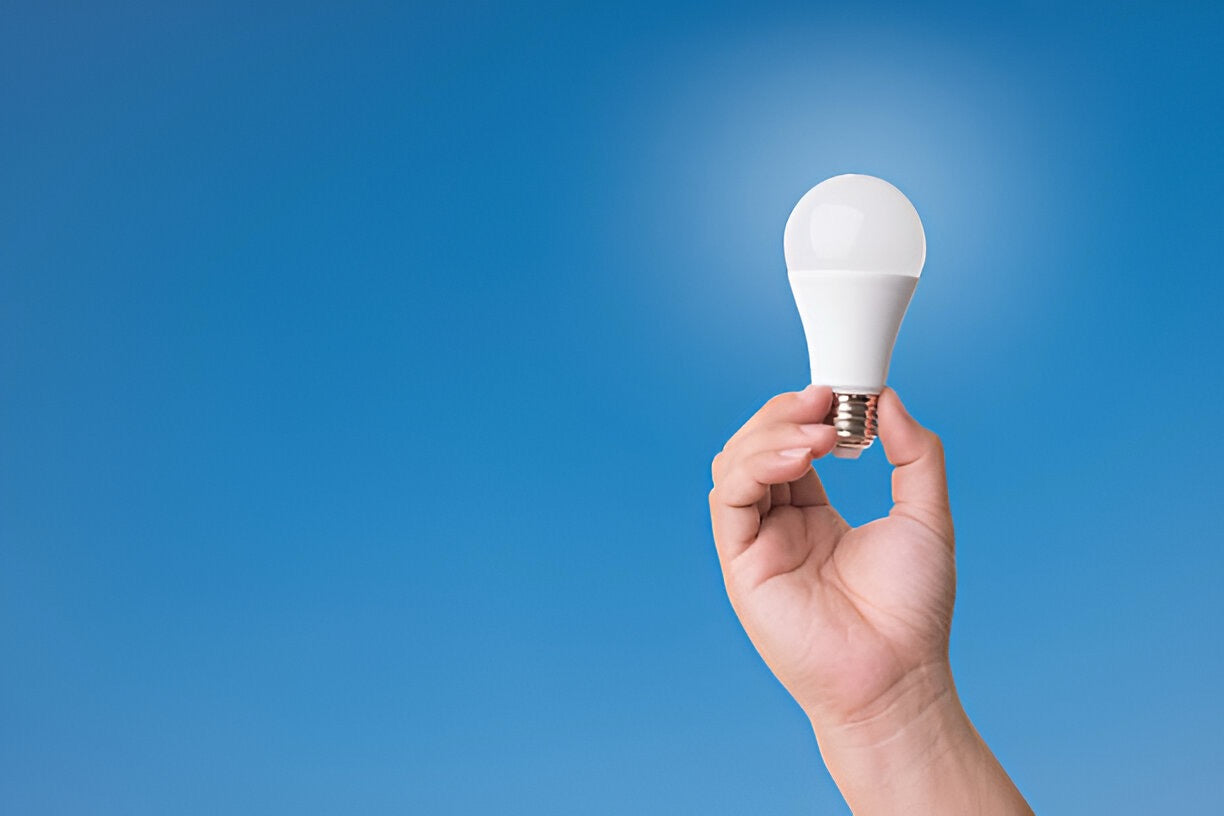


Choosing the right light bulb may seem simple, but with so many options, it can be overwhelming to navigate the world of lumens, Kelvins and energy efficiency. This comprehensive guide will help you understand the different types of light bulbs, interpret the confusing labels and ultimately make well-informed decisions to light your home efficiently and effectively. Whether you are replacing a burnt-out bulb or planning a complete lighting makeover, this guide will give you valuable advice on how to light your room optimally and ideally save energy costs at the same time.
Beyond simply providing light, light bulbs are crucial in determining the atmosphere of a room, affecting our emotions and influencing how much energy we use. The right lighting can highlight architectural details, provide targeted task lighting for work and hobbies, or create a cozy and inviting atmosphere. On the other hand, poor lighting can cause headaches, eye strain and higher energy costs. You can significantly reduce your energy consumption, create the ideal atmosphere and optimize your lighting for specific purposes by being aware of the different types of light bulbs and their characteristics. This guide explores the technical details while maintaining readability and usefulness for everyday use.
From inefficient and short-lived incandescent bulbs to the energy-efficient and long-lasting LEDs of today, the history of the light bulb is an exciting journey of invention. Let's explore the key turning points:
The first lighting revolution took place with the invention of the light bulb in the late 19th century. Heating a filament until it glows is how it works. Despite producing a cozy, pleasant glow, incandescent bulbs are notoriously inefficient; only a small portion of the electricity is converted into light, the rest is lost as heat. In many countries, incandescent lamps have been phased out due to their short life and high energy consumption. Their warm, yellowish light and classic bulb shape help to make them recognizable.
A halogen gas that allows the filament to burn hotter and produce a brighter, whiter light is what differentiates halogen bulbs from incandescent bulbs. Although they are marginally more energy efficient than incandescent bulbs, they still consume much more energy than newer models such as LEDs. Because of their bright, focused light, halogen bulbs are often used in task lighting and spotlights. They generate a lot of heat, similar to incandescent lamps.
Compact fluorescent lamps (CFLs) have become a more energy-efficient replacement for incandescent bulbs. To produce visible light, an electric current is passed through a gas-filled tube that emits ultraviolet light. This light then excites a phosphor coating inside the tube. Compared to incandescent bulbs, CFLs are more energy efficient and have a longer life. But because they contain mercury, they must be disposed of carefully. They can also be sensitive to frequent switching on and off and take a while to reach their full brightness. The spiral or folded tube shape is what characterizes CFLs.
The most remarkable development in lighting technology is LEDs. These are semiconductors that emit light when an electric current flows through them. Compared to incandescent bulbs, LEDs consume up to 85% less energy and have a much longer lifespan (often 15,000 hours or more). They offer a variety of color temperatures and brightness levels and are mercury-free. Because they are available in a variety of sizes and shapes and are becoming increasingly affordable, LEDs are a flexible option for virtually any application. In the long term, they are the most economical and environmentally friendly lighting choice.
There are many confusing technical terms and numbers on the packaging of light bulbs. The most important information that can be found on a light bulb label is broken down as follows:
Wattage (W): The wattage shows the amount of energy consumed by the light bulb. Less energy is consumed by light bulbs with a lower wattage. The wattage used to be a good indicator of brightness but is no longer a reliable indicator of light output due to the introduction of energy efficient light bulbs such as LEDs. Instead, look at lumens (see below).
Lumen (lm) The total amount of visible light emitted by a light bulb is measured in lumens. A brighter bulb has a higher lumen rating. Use this formula to find the equivalent lumen output when changing a light bulb:
Approximately 450 lumens from 40W incandescent lamp
About 800 lumens for a 60W light bulb
About 1100 lumens for a 75W light bulb
Incandescent lamp 100W: approx. 1600 lumen
Color temperature (K): The color temperature, expressed in Kelvin (K), indicates how warm or cool the light from the bulb is.
Warm white (2700K-3000K): Most light bulbs shine in warm white (2700K-3000K) and spread a warm, yellowish light. Perfect for creating a warm and cozy atmosphere in dining rooms, living rooms and bedrooms.
Neutral white (3500K-4000K): Similar to daylight, neutral white (3500K-4000K): Provides a more balanced light. Good color rendering and visibility make it ideal for offices, restrooms and kitchens.
Cool white(4500K-5500K): A bright, bluish-white light is specified as (4500K-5500K). Ideal for task lighting, garages and workshops, it maximizes focus and clarity.
Daylight (6000K-6500K): Simulates daylight. Used in areas where color accuracy and maximum visibility are critical.
Color rendering index (CRI): Color accuracy: Compared to natural sunlight, the CRI quantifies how accurately a light source reproduces the color of an object. Perfect color rendering is indicated by a CRI of 100. In rooms such as kitchens, bathrooms and studios, where accurate color representation is critical, bulbs with a higher CRI (80 or higher) are typically recommended.
Durability of the light bulb (hours): This indicates how many hours the bulb should last on average. Compared to incandescent or halogen bulbs, LEDs generally last much longer, which reduces the need for replacement.
Energy efficiency labels in many countries assign light bulbs a number between A (most efficient) and G (least efficient). Choosing light bulbs with a higher energy efficiency rating will reduce your impact on the environment and save you money on your electricity bill.
Not every light bulb can be dimmed. To ensure that the light bulb is compatible with dimmer switches, check the packaging. Both the light bulb and the dimmer can be damaged if a non-dimmable light bulb is used.
Make sure that the base type and bulb shape you have selected match your luminaires. Examples of common base types are:
The most common lamp base, E27 (Edison screw), can be found in ceiling lights and lamps.
Often found in chandeliers and smaller lamps, the E14 (Small Edison Screw) is a smaller version of the E27 socket.
Track lighting and spotlights often use GU10 (twist and lock).
One type of halogen or LED spotlight is the MR16 (multi-faceted reflector).
Choosing the right light bulb for each room in your home is crucial to achieving the desired atmosphere and practicality. Here are some general rules:
Living room: For a warm and inviting atmosphere, use warm white (2700K-3000K) light bulbs. To adjust the lighting to your mood, remember to use dimmable bulbs. Integrate ambient, task and accent lighting into your lighting design.
Bedroom: Warm white (2700K-3000K) bulbs are perfect for creating a calm and relaxing atmosphere, just like in the living room. For reading, use bedside lamps with programmable brightness. White lights that are too cool or bright should not be used in bedrooms as they can disturb sleep.
Kitchen: Good color rendering and visibility for food preparation is provided by neutral white (3500K-4000K) bulbs. To illuminate countertops, consider installing under-cabinet lights under the cabinets. White lights that are too warm or too cold should be avoided as they can alter the appearance of food.
Bathroom: Cool white (4500K) or neutral white (3500K-4000K) These bulbs are well suited for bathrooms and provide sufficient light for make-up and personal hygiene. Make sure that the bulbs are suitable for humid areas.
Office/study: For targeted task lighting, cool white (4500K-5500K) bulbs are the best choice. Lamps that are too warm should be avoided as they can make you sleepy. To adjust the lighting to your needs, consider using an adjustable desk lamp.
Corridors and entrances can be fitted with either neutral white (3500K-4000K) or warm white (2700K-3000K) light bulbs. Ensure that there is sufficient lighting for visibility and safety.
Outdoor lighting: Choose weatherproof bulbs that are suitable for outdoor use. For added security, consider using motion sensor lights.
Smart lighting: Smart bulbs offer cutting-edge features such as color change, remote control and integration with smart home automation. They allow you to set up automated lighting schedules and personalize your lighting to your liking.
Color changing bulbs: With these bulbs you can change the light color to create different atmospheres and moods. They can add a playful accent to your home or be used as accent lighting.
Light therapy: Seasonal affective disorder (SAD) and other conditions can be treated with special light bulbs that simulate natural sunlight.
A comfortable, useful and energy efficient home requires knowledge of the different types of light bulbs, reading the labels and choosing the right lighting for each room. Adopting LED technology and being aware of variables such as lumens, color temperature and CRI can greatly improve the quality of light in your life while reducing your carbon footprint and lowering your electricity costs. Now that you have the knowledge from this guide, you can confidently walk down the light bulb aisle and light up your world with the ideal lighting.